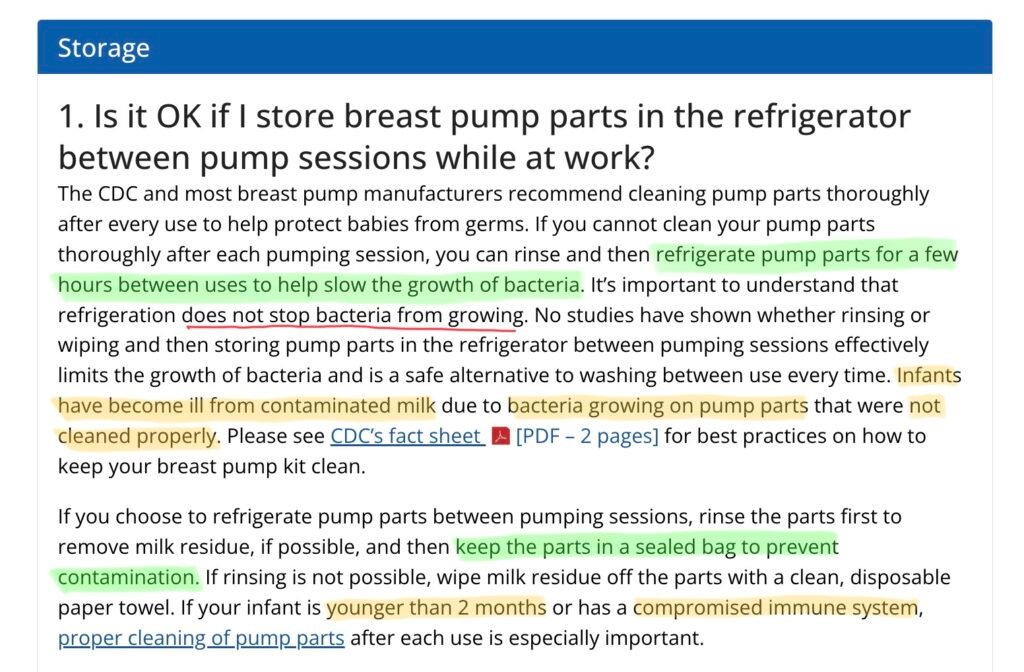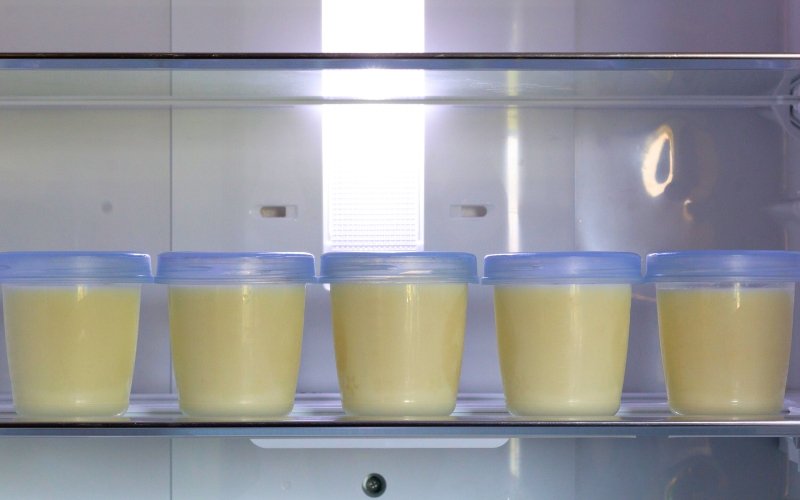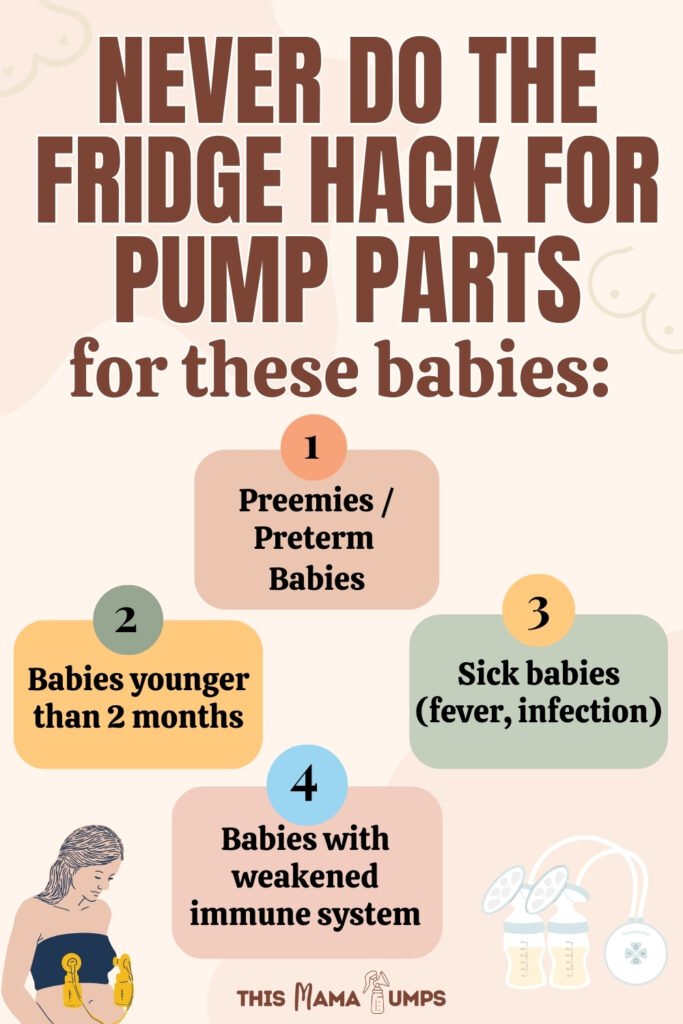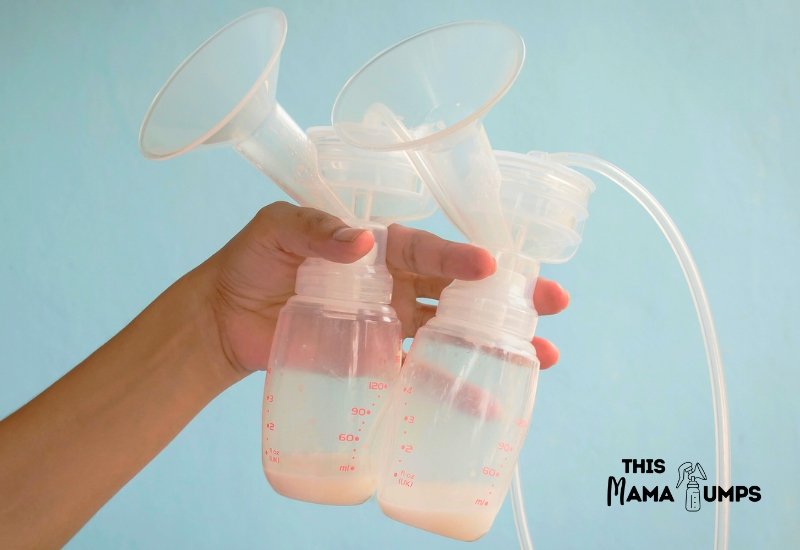If you’re a pumping mom or considering pumping, you’ve probably heard about the “fridge hack”.
Basically, this means putting your pump parts inside the refrigerator in between pumping sessions.
That saves you time instead of washing pump parts after each use.
Since breastmilk is good for up to 4 days inside the fridge, then used pump parts should be good in the fridge for a few hours, right?
Let’s see what the official guidelines say, the evidence behind it, and how this translates into practice in the real world with real moms.
Can i refrigerate pump parts between use?
Freshly expressed breast milk has bacteria-killing properties. [1]
And refrigeration slows down the growth of bacteria.
So it stands to reason that refrigerating pump parts is safe, right?
Well, not really.
Let’s see what the guidelines say.
What Do The Guidelines Say
Academy of Breastfeeding Medicine (ABM)
The Academy of Breastfeeding Medicine is a group of medical doctors who are experts in breastfeeding. They develop protocols for the clinical management of breastfeeding.
According to the ABM Clinical Protocol #8: [2]
“Breast pump milk collection kits must be completely dismantled, washed in hot soapy water and rinsed or washed in a dishwasher, and should always be thoroughly air dried or dried with paper towels. They do not need to be sterilized. If soap is not available, then boiling water is preferable.”
Center for Disease Control (CDC)
“Clean pump parts that come into contact with breast/breast milk as soon as possible after pumping. You can clean your pump parts in a dishwasher or by hand in a wash basin used only for cleaning the pump kit and infant feeding items.”
The CDC first released their official guidelines on how to clean breast pumps back in 2017. [3]
This was in response to a preterm infant getting critically ill due to a contaminated breast pump. [4]
Back then, there was very limited information on breast pump hygiene.
(Read more about how the CDC Guidelines changed over the years.)
What does the CDC say about the fridge hack?
Sure, in an ideal world, we would be cleaning pump parts AFTER. EVERY. USE.
But moms are often too tired and too overwhelmed.
Pumping hacks like this are what usually save moms’ breastfeeding journey.
When asked about refrigerating pump parts, Dr. Anna Bowen, a CDC medical officer, told Parents magazine: [5]
“Although refrigerating used pump parts between uses might be OK if the pump kit is not contaminated, cleaning the pump kit after each use is safest and is particularly important for babies who are younger than two to three months old, were born prematurely, or have weakened immune systems.”
The fridge hack is so commonly used by moms that it has its own entry in the CDC Breast Pump Cleaning FAQ page (see screenshot below). [6]

Despite these guidelines, I know many moms (myself included) DO NOT RINSE OFF pump parts before putting them inside the fridge. As that would be another way for introduce bacteria to the pump.
What about Breast milk’s bacteria-killing properties?
Yes, studies has shown that human milk has antimicrobial capacity against C. sakazakii and other microorganisms. [7]
But, that germ-fighting capacity is reduced through handling and storage (refrigerating and freezing).
Freshly expressed milk contains the highest antimicrobial and immunologic properties. But if you need to store it in the fridge, make sure to give it to your baby within 72 hours (3 days). [7]

According to the CDC, germs can grow quickly in breast milk or breast milk residue that remains on pump parts. Infants have become ill from contaminated milk due to bacteria grown on pump parts that were not cleaned properly. [8]
So yes, properly cleaning your pump parts is very much important.
Never Do The Fridge Hack For These Babies:

- preemie/born premature – these are babies who were not born FULL TERM (i.e, babies born less than 37 weeks)
- younger than 2 months old – newborn babies and those in the earlier months have a less developed immune system
- sick – if your baby is currently battling an infection or has a fever
- weakened immune system
What if you have a healthy, full term baby?
It’s still best to wait until your baby is at least 2 months old before attempting to do the fridge hack.
Ultimately, it’s a risk you have to be willing to take.
There are risks to everything, including not feeding human milk.
You decide what’s best for your family, given your circumstances.
How to store pump parts in fridge
If you do decide to try the fridge hack, here’s now to do it:
- After pumping, transfer milk to a storage container.
- Put breast pump parts inside a ziploc bag, wet dry bag or plastic container. This prevents pump parts from getting contaminated by other items inside the fridge.
- Don’t disassemble parts to avoid contamination.
- If possible, have a dedicated refrigerator shelf for breast milk and pumping supplies.
Do this for 2-3 pumping sessions max (or 8-12 hours in the fridge).
And then, take apart pump parts, wash and sanitize (sterilize) them.
PRO TIP: Get extra breast kits so you don’t have to wash after each pumping session. You can put all the used breast kits in the dedicated wash basin and wash them all at the end of the day.
Have You Tried The Fridge Hack?
What about you?
Have you tried the fridge hack? Is this something you’re comfortable doing or not?
Let me know in the comments below!
References:
- Mohrbacher, N. (2020). Breastfeeding answers: A guide for helping families. (2nd ed.). Nancy Mohrbacher Solutions, Incorporated.
- Eglash, A., Simon, L., & Academy of Breastfeeding Medicine (2017). ABM Clinical Protocol #8: Human Milk Storage Information for Home Use for Full-Term Infants, Revised 2017. Breastfeeding medicine : the official journal of the Academy of Breastfeeding Medicine, 12(7), 390–395. https://doi.org/10.1089/bfm.2017.29047.aje
- Centers for Disease Control and Prevention. (2017). How to Keep Your Breast Pump Kit Clean: The Essentials. CDC. https://www.cdc.gov/healthywater/hygiene/healthychildcare/infantfeeding/breastpump.html
- Bowen, A., Wiesenfeld H. C., Kloesz J. L., Pasculle, A. W., Nowalk A. J., Brink L., Elliot, E., Martin, H. & Tarr, C. L. (2017). Notes from the Field: Cronobacter sakazakii Infection Associated with Feeding Extrinsically Contaminated Expressed Human Milk to a Premature Infant — Pennsylvania, 2016. CDC Morbidity and Mortality Weekly Report, 66(28), 761–762. DOI: http://dx.doi.org/10.15585/mmwr.mm6628a5
- Donvito, T. (2017, July 21). The CDC’s New Breast Pump Cleaning Guidelines Are a Must-Read for Pumping Moms. Parents. https://www.parents.com/health/parents-news-now/cdc-issues-breast-pump-cleaning-guidelines/
- Centers for Disease Control and Prevention. (2023). Frequently Asked Questions on Breast Pump Cleaning. CDC. https://www.cdc.gov/hygiene/childcare/breast-pump-cleaning-FAQ.html
- Fernández-Pastor, S., Castelló, D. S., & López-Mendoza, M. C. (2021). Stability of the Antimicrobial Capacity of Human Milk Against Cronobacter Sakazakii During Handling. Journal of human lactation : official journal of International Lactation Consultant Association, 37(1), 139–146. https://doi.org/10.1177/0890334420932574
- Centers for Disease Control and Prevention. (2024). About Breast Pump Hygiene. CDC. https://www.cdc.gov/hygiene/about/about-breast-pump-hygiene.html

